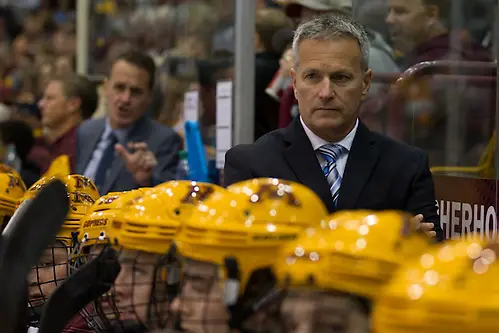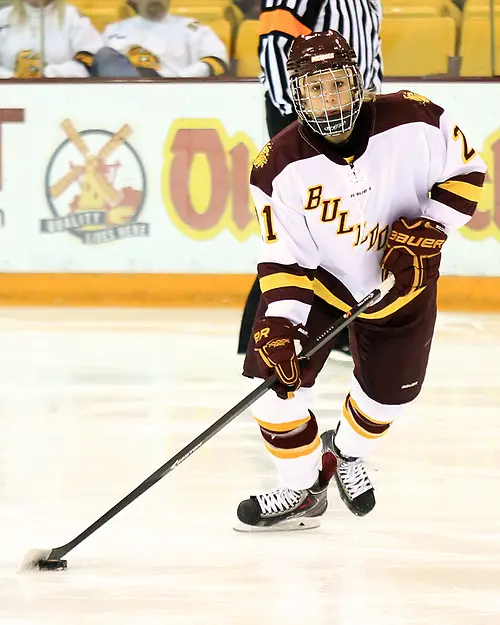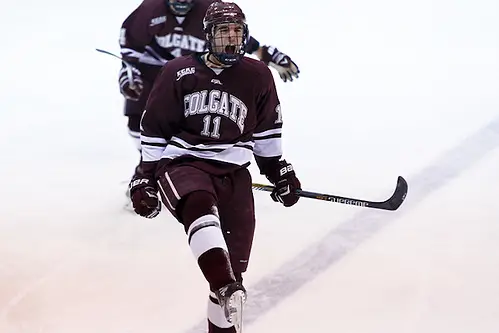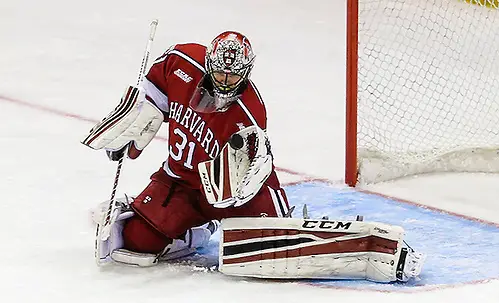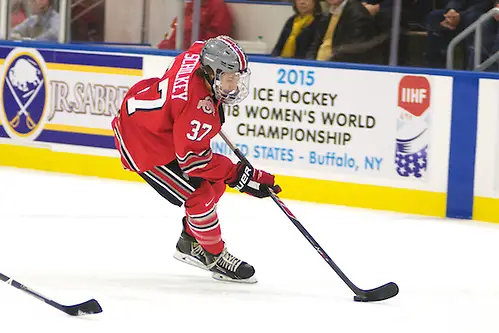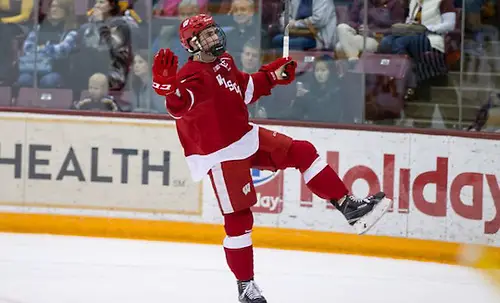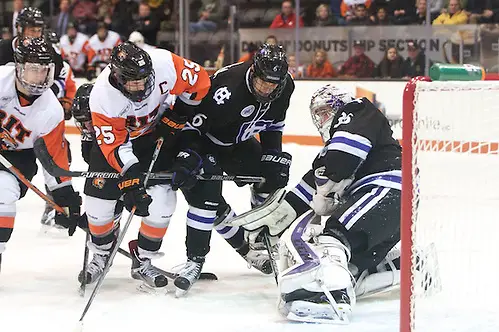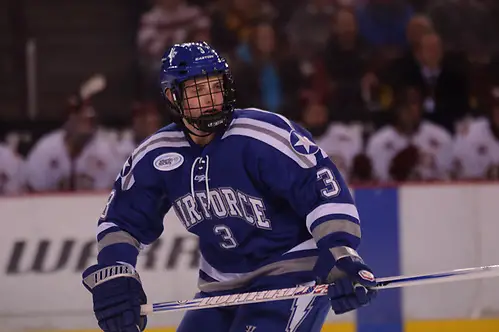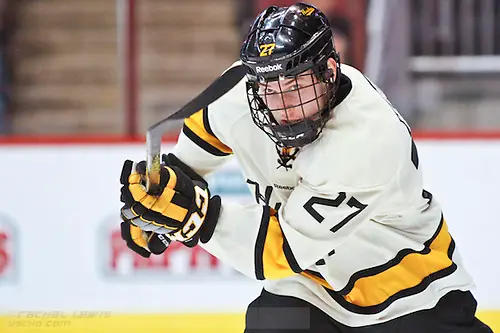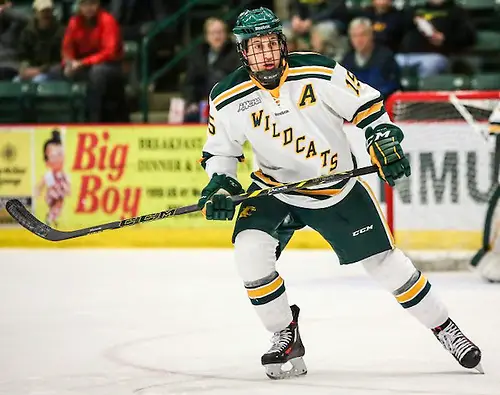
With the 2016-17 season here, how do the teams stack up in Hockey East?
Our columnists make valid points and make bold predictions.
Boston College
If Boston College were any other program, you might resign to the fact that 2016-17 will be a rebuilding season.
It looked like after last season’s run to the Frozen Four, BC would suffer just slight losses from graduation. Defenseman Teddy Doherty was the only member of the senior class that made significant contributions on the scoresheet.
But when the season ended, professional signings began.
And continued.
And continued even more.
When the dust settled, the Eagles lost seven players to NHL contracts. At forward, Alex Tuch, Adam Gilmour, Miles Wood and Zach Sanford all inked deals. The blue line became thinner after Steve Santini and Ian McCoshen left. And the cherry on the top was goaltender Thatcher Demko, recipient of last year’s Mike Richter Award, signing with Vancouver.
Rebuilding year, right? Well, not so fast.
For one, it’s not like Jerry York and his coaching staff didn’t see many of these signings coming and thus planned accordingly. Pro signings for this program are commonplace and succession planning is part of the day-to-day operations.
Additionally, the Eagles have proven in the past they can reload with the best of them. Sure there may be hiccups, but seven NHL early departures isn’t going to be a postscript for this program.
That doesn’t mean there isn’t a lot of confusion and clutter when figuring out just how strong this team will be. Hockey East coaches picked BC sixth but national voters selected the Eagles fifth in the first USCHO.com poll.
Confused yet?
Last season
28-8-5, 15-2-5 Hockey East (T-1st). Lost to Northeastern in Hockey East semifinals.
Names to know
Though BC lost more than any other team in the nation in the offseason, it returns its top two scorers in Ryan Fitzgerald and Colin White.
Three questions
1. Without Thatcher Demko in net – or any real game experience – how good can this Eagles team be?
2. Will team defense be an issue with so little experience on the blueline?
3. Is earning a first-round bye a real issue for this perennial powerhouse?
Crystal ball
Jim Connelly picks the Eagles: 5th
Dave Hendrickson picks the Eagles: 6th
Boston University
When you look at Boston University’s roster, the talent can be staggering.
Forget the fact the Terriers were the Belle of the Ball at the 2015 NHL Draft with four players selected in the top 50. This past summer, BU had four players from this year’s team selected in the opening round of the draft, matching the 2007 Minnesota Golden Gophers for most in a single draft by a college team.
Most are familiar with Charlie McAvoy, who enters his sophomore campaign. Add to that first-rounders Clayton Keller, Dante Fabbro and Kieffer Bellows, and one single draft could be the harbinger of a national title.
But as the Gophers learned in 2007, draft picks don’t create a championship. The ability to take all-star caliber players and make them come together as a team can be a challenge.
“There is so much that goes into having success at our level,” said BU coach David Quinn. “The talent gives you an opportunity, and then as a group you have to collectively acquire mental toughness, perseverance and work ethic.”
Certainly, Quinn may want to downplay the talent of his team, but he’s also careful to balance out that there are 11 other teams that not just want to win a championship, but certainly want to knock off the talent-heavy Terriers.
“[The season beginning] is an exciting time for everybody, but it’s not more exciting for us than anyone else,” said Quinn. “It’s the start of a new season and each team is going to form its own identity.”
For BU, that identity can go many ways. There is scoring talent in spades, but adding depth the blueline players like McAvoy could make this BU team a difficult one against which to score.
Certainly Quinn is excited for his incoming class, possibly the strongest in the nation. But it will be difficult to get too much excitement from him before the puck drops.
“It was an exciting offseason for us,” said Quinn. “But how many times do you in sports where people have an exciting offseason but don’t get it done during the real season.”
Last season
21-13-5, 12-6-4 Hockey East (fifth). Lost to UMass-Lowell in Hockey East quarterfinals.
Names to know
There are plenty to mention here, particularly with four first-round NHL Draft picks this past June. Jakob Forsbacka-Karlsson up front and Charlie McAvoy on the blueline are just two of a large roster whose names you will hear this season.
Three questions
1. With so many great players, will there be enough offense to spread around?
2. Who will step forward as this team’s go-to guy in net?
3. Expectations can be one of the toughest things to handle in college sports. Are the Terriers ready?
Crystal ball
Jim picks the Terriers: 1st
Dave picks the Terriers: 1st
Connecticut
When UConn made its move to Hockey East, everyone knew that Rome could be built in a day and there could be come growing pains for the Huskies program.
But many of those pains have been minimized through two seasons and UConn has quickly become a team knocking on the door trying to unseat Hockey East’s perennial powers.
The Huskies earned a home ice spot in the opening round of last year’s playoffs and this season are picked seventh in the preseason coaches poll, just a single spot below Boston College.
The team is comprised of experienced players with 14 key contributors coming from either the sophomore or junior class. Leading that list is a duo that last year received nationally attention: Max Letunov and Tage Thompson. Last season, the pair combined for 30 of UConn’s 88 goals.
If there is a group of players that Huskies coach Mike Cavanaugh wants to rely more upon, though, it is his junior class. Players like Spencer Naas, Jesse Schwartz and Kasperi Ojantakanen have all showed ability but now will be leaned on for leadership.
“Our junior class has played two years in Hockey East,” said Cavanaugh. “They understand the opponent. And that certainly helps when playing in this league.
“On most given night, there’s eight of those guys from the junior class that are going to be in the lineup. That’s a big portion of your team.”
One of the most important members of the team is not part of the junior class and that is senior goaltender Rob Nichols.
Nichols was flashy and brilliant in his first Hockey East season as a sophomore. Last season, he remained strong but was required to make nearly 300 less saves with the team defense strengthening around him.
“Our team defense got better [last year],” said Cavanaugh. “Because our team defense got better, some of the [offensive] numbers for some players suffered.
“However, they became better defensive players and that was very encouraging to me. I felt better about the development of them as 200-foot hockey players.”
Last season
11-21-4, 6-12-4 Hockey East (8th). Lost to Vermont in Hockey East first round.
Names to know
Tage Thompson and Max Letunov were standouts as rookies and are a focal point in year two. Goaltender Rob Nichols, though, may be this team’s glue in net.
Three questions
1. UConn has a talented top line, but how deep can the offense go after that?
2. Will the Huskies team defense take enough pressure off Rob Nichols for him to emerge as a top Hockey East goaltender
3. Are the Huskies ready to handle expectations and push to be a top-six team in this conference?
Crystal ball
Jim picks the Huskies: 8th
Dave picks the Huskies: 7th
Maine
Question are abound for Maine, which is coming off an 11th place finish, the lowest ever for a Black Bears program that has three regular-seaon and five postseason titles.
The biggest question might be can this team score. Last season, Maine was last in Hockey East and 55th of 60 nationally in scoring, averaging just 2.00 goals per game.
“We have some excellent players coming back like Cam Brown, Nolan Vesey and Blaine Byron,” said coach Red Gendron. “They’re players who didn’t necessarily put up numbers like we all expected them to a year ago.
“But they’re determined. They came back in great shape and I expect to get a heck of a lot more production from them.”
And while offensive production will be critical, defense and goaltending has to improve as well. Last season, only Massachusetts allowed more than Maine’s 3.39 goals per game in the league.
In goal, Maine will rely on Rob McGovern and Matt Morris to improve and will hope to tighten up the team defense in front that allowed more than 30 shots on goal per game.
Maine does have a strong recruiting class coming in that includes three players selected on June’s NHL Draft.
“With three draft picks in the [freshman] class, we’re excited,” said Gendron. “There’s always a learning curve, but I think our freshman class is more talented.”
Last season
8-24-6, 5-15-2 Hockey East (11th). Lost to Northeastern in Hockey East first round.
Names to know
Cam Brown and Blaine Byron will be leaned upon to somehow get this Maine offense going this year while goaltenders Rob McGovern and Matt Morris need to provide stability on the back end.
Three questions
1. Is this team committed to playing defense? Three-plus goals against a game won’t cut it in Hockey East.
2. Will players Brown, Byron and Nolan Vesey go from good to great and help spark this Maine offense?
3. How much impact can a freshman class with three NHL Draft picks have in bringing the Black Bears out of league’s bottom tier?
Crystal ball
Jim picks the Black Bears: 12th
Dave picks the Black Bears: 11th
Massachusetts
When Massachusetts decided last April to make a coaching change, athletic director Ryan Bamford made one thing clear: he was going to be the single-man search committee and he was out to get the best candidate possible.
Bamford may have done exactly that attracting young and energetic (and, thus far in his career, successful) Greg Carvel from St. Lawrence to lead the Minutemen. Carvel, who took over for legendary Saints coach Joe Marsh in 2012, took a program that had posted two sub-.500 teams and turned it around to finish above .500 in three of his four seasons.
The task to make St. Lawrence successful may have been a bit of a challenge, but it will pale in comparison to what Carvel faces in Amherst. When Carvel arrived at St. Lawrence, the Saints were only six seasons removed from the ECAC regular season title and an NCAA appearance.
Compare that to UMass, where the Minutemen have never won a regular or postseason title, only finished in the top four of Hockey East twice and has made just a single NCAA appearance.
That, though, won’t deter the 46-year-old coach from trying. But he’s also realistic that change can’t happen overnight.
“I feel like we’re taking small steps and figuring out the team we need to be and how we have to play,” said Carvel. “I watched 8-10 games from last year and realize how I coach is different than what they were getting last year.
“So we’re starting from scratch in a lot of ways. That takes times. I’ve coached enough teams to know it takes time for those things to evolve.”
Last season
8-24-4, 2-16-4 Hockey East (12th). Lost to Boston University in Hockey East first round.
Names to know
Austin Plevy’s freshman campaign gives a lot of hope that he can be an offensive leader. But UMass’ key may be in net where Nic Reynard and Alex Wakaluk have to find a way to lower the Minutemen’s goals against.
Three questions
1. Can Greg Carvel put his stamp on the UMass program out of the gate?
2. Who can help replace Shane Walsh and Dennis Kravchenko on an offense already struggling to score goals?
3. Can the Minutemen get enough consistency in goal to have a go-to guy night in and night out?
Crystal ball
Jim picks the Minutemen: 12th
Dave picks the Minutemen: 11th
Massachusetts-Lowell
There are few teams that can enter a season ranked top 10 nationally yet still have a major question mark looking over its head.
That is the case, though, for UMass Lowell. A game away from the Frozen Four a season ago, the River Hawks bring back plenty of experience. Except, in goal.
But pundits are willing to cut coach Norm Bazin a break when it comes to goaltending as his and his staff’s pedigree when it comes to recruiting and developing netminders is strong.
Maybe worried two seasons ago when Connor Hellebuyck left for the NHL what would happen in net. What happened was Kevin Boyle, a transfer from Massachusetts, developed into one of the league’s top goaltenders, leading Lowell to the Hockey East finals in each of his two seasons.
So as Lowell enters this campaign with solid depth at forward and an experienced and talented defensive corps, there will be plenty of competition for which goaltender or goaltenders can lead this team.
Bazin will have four options – two sophomores in Sean Cleary and Christoffer Hernberg, and two rookies, Tyler Wall and Garrett Metcalf.
As the season begins, all four are in the competitive mix for Bazin, and that something he seems to enjoy.
“We’re trying to figure people out, so it’s an exciting time,” said Bazin. “These are young men who are going to make mistakes. Goalies are going to make mistakes just like defensemen are. However, if you can tolerate the mistakes and track their development over the first five games, let’s say, you’ll find out who you’re really going to have in net.”
Last season
26-10-5, 13-6-4 Hockey East (4th). Lost to Northeastern in Hockey East final.
Names to know
Lowell will have the firepower with players like Joe Gambardella, C.J. Smith and Nick Masters helping pace the offense. But the biggest question is in net where four inexperienced keepers will vie to replace Hockey East co-MVP Kevin Boyle.
Three questions
1. It’s about goaltending. Which of the four goalies on the Lowell roster can replace Kevin Boyle?
2. How much can an experienced blueline corps help solidify the defense and bolster the offense?
3. Can Smith and Gambardella prove they are ready to be mentioned among the league’s top forwards?
Crystal ball
Jim picks the River Hawks: 3rd
Dave picks the River Hawks: 2nd
Merrimack
There is plenty for Merrimack coach Mark Dennehy to like about this year’s team. And much of that rolls over from the finish of last year’s campaign.
Merrimack earned home ice in the opening round of the Hockey East playoffs. As they’re known to do, they created a great atmosphere in Lawler Arena, rallied from a game down against New Hampshire and won the best-of-three series. The Warriors then put forth two hard-fought efforts against Providence in the quarterfinals before ultimately falling.
Knowing that this year’s Warriors team returns a number of key contributors from last year’s squad gives Dennehy the confidence.
“We knew last year was going to be ups and downs and we would’ve liked the downs to be not so low,” said Dennehy. “But we liked how we finished.
“Our program has only hosted a playoff series three times and as bad as last year was at times, we were able to squeak out home ice in the first round. And that first-round win over UNH gave our young guys so much experience.”
This year’s team will be, as Dennehy calls it, “in their sweet spot.” The roster features just three seniors but is laden with talent in the sophomore and junior class.
“We’re going to be as deep as we have since I’ve been here. I don’t think we have the same marquee players as we did in [the NCAA team of] 2011,” said Dennehy. “But we’re deep.”
Last season
13-19-7, 5-10-7 Hockey East (7th). Lost to Providence in Hockey East quarterfinals.
Names to know
There should be plenty of fire power for Merrimack with players like Brett Seney and Hampus Gustafsson more mature and experienced. The question is whether players like Jace Hennig and Mathieu Tibbet can improve enough to make Merrimack a team with more scoring depth.
Three questions
1. Does experience in the Warriors locker room translate onto the ice?
2. Will this team get the leadership that coach Mark Dennehy wants and needs?
3. Which goaltender will step forward and is that enough to elevate the Warriors to a top-tier team in Hockey East?
Crystal ball
Jim picks the Warriors: 9th
Dave picks the Warriors: 10th
New Hampshire
As a college hockey team, one not-so-unreasonable expectation is that when your team struggles, there won’t be a ton of attention paid to your club. Because of that, even your top talent often misses out on opportunities to leave early for the NHL.
Not the case for New Hampshire. Despite a difficult year that produced just 11 wins, the least in coach Dick Umile’s 26-year tenure with the program, forward Andrew Poturalski was plucked from the Wildcats as an NHL free agent after just two seasons.
Thus, a difficult task of rebuilding for Umile got even tougher.
“Like everybody, you lose people to the pros and to graduation,” said Umile. “Our nucleus is younger and we’ve got work to do in a very, very strong league. So it’s going to be a work in progress, no doubt about that.”
The Wildcats will look to Poturalski’s linemate Tyler Kelleher to help pace the offense. A 46-point scorer a season ago, the senior has successfully produced each of the last two seasons offensively and will have the opportunity to mold some of the underclassmen like Marcus Vela and Shane Eiserman.
But for a UNH team that might struggle to score, the biggest question may be in goal. Two years ago, Danny Tirone came in after the holiday break and was the best storyline of the second half, going 14-6-0, leading the Wildcats to a berth in the Hockey East semifinals after upsetting eventual national champ Providence.
Last year, though, Tirone’s numbers were pedestrian but he was forced into action the bulk of the season after Adam Clark was tore his labrum and required surgery after starting the year with two solid wins.
“We’ll have both of them going,” said Umile. “Clark’s back and he looks great. So he and Tirone will battle on the weekends and we’ll see where it goes from there.”
Last season
11-20-6, 4-12-6 Hockey East (10th). Lost to Merrimack in Hockey East first round.
Names to know
The departure of 22-goal scorer Andrew Poturalski to the NHL leaves a big hole up front for the Wildcats, but Tyler Kelleher certainly has the talent if UNH can find a supporting cast. Look for players like Shane Eiserman and Marcus Vela to move from role players to top line forward that can help lead this offense.
Three questions
1. Where will the goals come from? New Hampshire has to be deeper than a one-line team.
2. Can Danny Tirone return to the form he showed as a freshman?
3. Who will step forward as this team’s leader?
Crystal ball
Jim picks the Wildcats: 10th
Dave picks the Wildcats: 8th
Northeastern
When a team hasn’t won any sort of championship in nearly three decades, you would think that there would be a good bit of satisfaction around the program.
But for Northeastern, which captured the Hockey East title last season for the first time since 1998, that’s not necessarily the case.
“I like the mindset out team has,” said head coach Jim Madigan. “Although we won the [Hockey East] championship, there was a little bit of unfinished business the way the NCAA tournament went (a 6-2 first-round loss to North Dakota).
“That corps has got a hungry taste in their mouth that we want to take our team to another level.”
Memory may serve the average fan that last year was hardly a season of unicorns and ponies for Northeastern. Despite hoisting the Lamoriello Trophy around TD Garden, the Huskies dug themselves into a 1-12-2 hole to start the year before assembling a 13-game winning streak that culminated at the Garden. It was the second straight year Northeastern started the season slow and something that Madigan hopes his team can steer as far away as possible from this season.
“It’s been the last two seasons we had the slow starts,” said Madigan. “The seniors went through this as sophomores and juniors so they understand that a big part of our success is how we get off to a start. We can’t expect to be going on these great runs.”
Last season
22-15-5, 10-9-4 Hockey East (6th). Won Hockey East Championships.
Names to know
Plenty of key components from the defending Hockey East champs return, most notably John and Nolan Stevens and Zach Aston-Reese. Ryan Ruck again will be the go-to guy in net and this team’s success will align with his.
Three questions
1. Can the momentum from the end of last season return – and more importantly be there right out of the gate.
2. Will Ryan Ruck be the same goaltender he was a year ago?
3. Can this team produce with some of the highest expectations they’ve had in years?
Crystal ball
Jim picks the Huskies: 4th
Dave picks the Huskies: 4th
Notre Dame
It seems like only yesterday we were saying hello to Notre Dame. Now, we’re saying goodbye.
After a brief four-year stay in Hockey East, Notre Dame begins its swan song before heading to the Big Ten Conference next season. And the Irish, a perennial national contender since Jeff Jackson took over the program in 2005, still have plenty of unfinished business.
Since joining Hockey East, Notre Dame has yet to win a championship or even reach the title game. The Irish fell to UMass-Lowell in their only appearance at the Garden and last season was their best regular-season finish, third place, before looking to the Northeastern juggernaut.
And by all accounts, this could be the best Notre Dame team to take the ice in the four years. Goaltender Cal Peterson, voted the team’s captain, should be an early favorite for Player of the Year.
If there is one question for the Irish, it is whether this team can score. Despite losing just four senior forwards, all reached the double-digit mark in goals scored.
“Going into the season concerned about one area, it may be are we going to score,” said Jackson. “But I thought that would be an issue last year and it ended up not being so. You just hope guys develop to a point where they gain confidence in their game and they’ll get opportunities.”
“I like the group that we have here. You always have to count on the guys you have getting better. We had guys here last year not getting a lot of power play time like Dylan Malmquist and Andrew Oglevie. You expect that they’re going to be more productive.”
Last season
19-11-7, 15-5-2 Hockey East (3rd). Lost to Northeastern in Hockey East first round.
Names to know
While it is easy to point out many team’s top offensive contributors, with Notre Dame you can’t skip past Cal Peterson, who will lead this team in goal. That said, he’ll need goal support and the trio of Anders Bjork, Jake Evans and Jordan Gross will be among those called upon to keep the offense on pace.
Three questions
1. Will this Notre Dame score goals? If the Irish can produce offense, they could be deadly.
2. Is Cal Peterson ready to be the best player – not just goaltender – in Hockey East?
3. Will the Irish go out with a bang? Leaving the CCHA, Notre Dame won the league title. Can it happen again?
Crystal ball
Jim picks the Irish: 2nd
Dave picks the Irish: 3rd
Providence
When Providence graduated a senior class of eight players, including its four leading scorers, a season ago, head coach Nate Leaman knew he had rebuilding task ahead of him.
Add to that the fact that goaltender Nick Ellis signed a pro contract after just one season in the full-time starter’s job and that task grew larger.
Thus, this year’s Friars team will have a bit of a new look to it. Role players will become leaders and freshman will have the chance to become immediate contributors.
“It’s a young team in the fact that our older players are jumping into new roles and, we graduated a big class, so we have a lot of freshmen who have come in,” said Leaman. “But I believe that we have a pretty good talent level. Now it’s learning to manage the games and making sure that we play together.”
Leaman isn’t in a dissimilar situation from four years ago when last year’s seniors were freshman. The main difference, though, is Providence is now a program in the national conversation year-in and year-out after winning the 2015 national championship.
“Four years ago, when we had the big freshman class come in, the program wasn’t where it is now,” said Leaman. “Those guys didn’t have a lot of expectations. They could make mistakes.
“This team is a good team but there are expectations on this team. It’s how we grow and manage those expectations and stay in the day-to-day process of getting better.”
In goal, Hayden Hawkey, understudy to Ellis a season ago, will take center stage. Leaman hopes his experience in juniors and his learning last season allows him to have an impact from day one.
“I think Hayden has a lot of experience as far as playing in the USHL. I thought he developed a lot throughout our goaltending work last year,” said Leaman. “Because he is the returning guy, he has a little bit better of a feel of what to expect in a game.”
The biggest returning player is defenseman Jake Walman. He battled through injuries much of last season but still earned All-America honors. Leaman will look to leverage his talent and experience to help guide the team from the blueline.
“Jake is a game-changer at this level,” said Leaman. “The strength of our team is the defensive corps until we can get some of these young guys adjusted.
“He’s hungry and he’s looking forward to getting back.”
Last season
27-7-4, 16-3-3 Hockey East (T-1st). Lost to UMass-Lowell in Hockey East semifinals.
Names to know
The Friars lost a lot offensively, but still return junior Jake Walman, a 13-goal scorer in action limited by injury a year ago. One of the game’s best names, Hayden Hawkey, will also need to be one of the best players for Providence if he is to replace Nick Ellis in goal.
Three questions
1. Who will fill all of the holes? Lots of offensive losses along with the early departure of goaltender Nick Ellis places plenty of questions on this team?
2. Did the NCAA title of 2015 create a legacy? A national title usually helps with recruiting. That’s something we might see this year.
3. Where will the stabilizing factor come from? Will it be a goaltender who shines, a blueline that becomes unstoppable or simply the system’s of a coach that helps this team win?
Crystal ball
Jim picks the Friars: 6th
Dave picks the Friars: 5th
Vermont
Vermont coach Kevin Sneddon admits that there was something missing from his locker room last season.
“The one thing you don’t always know as a coach when you look at your team on paper, is maturity going to be on our side,” said Sneddon. “That’s certainly going to be the case this year.”
Returning a roster of talented experienced players featuring eight seniors and seven juniors, Sneddon hopes that the experience of this club – including earning a first-round sweep of Connecticut and coming within a whisker of upsetting Boston College in the quarterfinals – can be something that propels the Catamounts to the top third of Hockey East.
“We played well down the stretch,” said Sneddon. “I think that was the message, ‘We played well down the stretch, now we have to get that going earlier.’ Last year’s team got along really well but I don’t think there was accountability.”
“The seniors combined with the juniors are doing a great job of leading and holding guys accountable. It’s all about setting standards.”
Last season
15-22-3, 6-13-3 Hockey East. Lost to Boston College in Hockey East quarterfinals.
Names to know
The Catamounts return its top three scorers – Mario Puskarich, Brendan Bradley and Jarrid Privitera – along with senior Brady Shaw who had flashes of offensive brilliance his sophomore year. Mike Santaguida is the experienced tender but will be pushed by rookie Stefanos Lekkas for time between the pipes.
Three questions
1. Will Santaguida be the man in net for the Cats?
2. Does this team have the depth and maturity to be a top-tier team?
3. Can the Catamounts stay healthy? Injuries and a lack of depth too often have hurt this club.
Crystal ball
Jim picks the Catamounts: 7th
Dave picks the Catamounts: 9th

